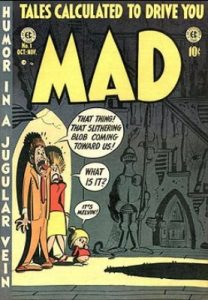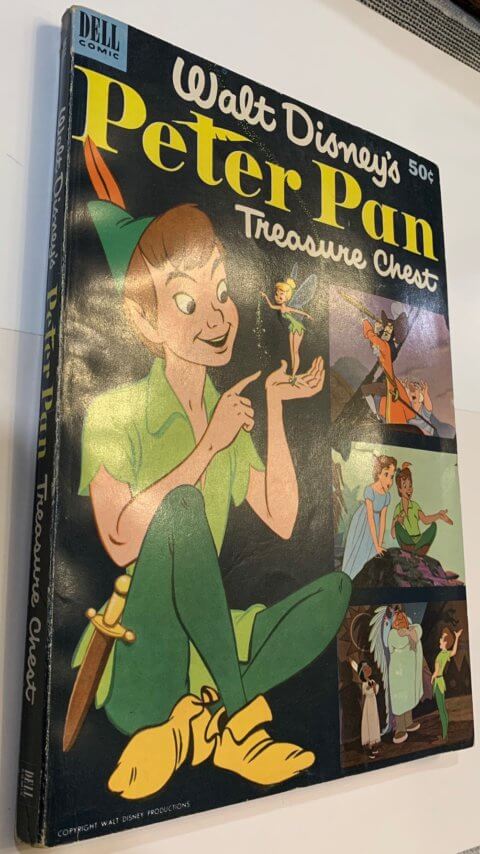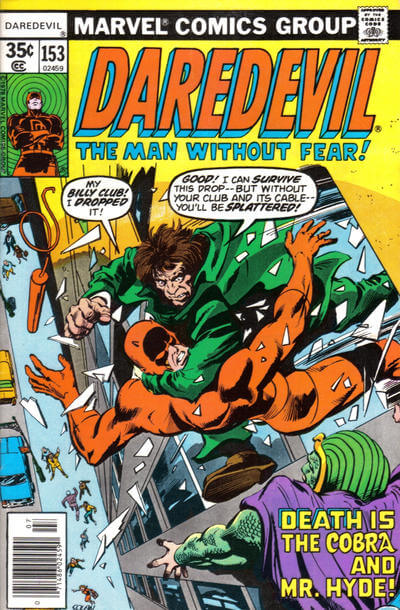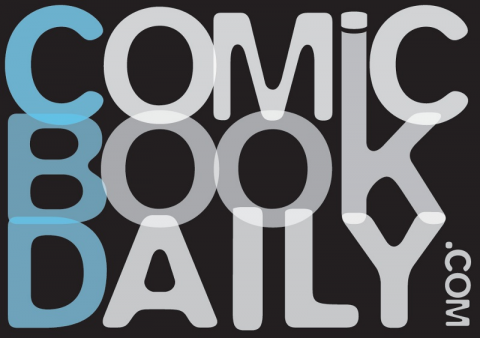 Mad #1, EC Comics, Oct/Nov 1952.
Mad #1, EC Comics, Oct/Nov 1952.
Last week I was offered a mid-grade copy of Mad #1 and I turned it down. In my judgement the book was flat, I thought I’d have trouble selling it, I couldn’t remember the last time someone asked me to hunt one of those down.
The book has been stuck in my brain ever since, it’s like my Spider Sense is telling me I messed up by passing on it. Obviously some therapy is needed, obviously Mad #1 is this week’s Undervalued Spotlight.
Mad #1 was published in 1952 by E.C. Comics. Publisher William Gaines could do no wrong in the early 1950s, his E.C. lineup was the class of the field boasting some of the best creative talent in the business. Comics.org quotes the F.B.I. pegging the print run for #1 at 400,000. Today the print run remains healthy, somewhere over 250,000 is what I read. Mad’s heyday was the 1970s when the print run was over 2 million copies per issue.
Mad is a satire magazine that parodies, questiones, pokes fun and exposes the absurdity of most things sacred in American popular culture. It’s hard to overstate Mad’s importance and influence. The quote’s from famous writers, comedians, reporters, film critics etc. are all over the web, they all site Mad’s massive influence, just jump on Wiki for some testimonials. I liked the quote from Comics historian Tom Spurgeon who argues that at the height of Mad’s influence it was The Simpsons, The Daily Show and The Onion combined. Some write that Mad set up the kids that would later launch the sexual revolution, the anti Vietnam movement etc. Those are pretty strong associations but the point to take from all these testimonials is that Mad was a very, very influential publication whose effects we’re are all enjoying today in many forms of media.
The creator talent allocated to Mad #1 is beyond impressive, Harvey Kurtzman, Jack Davis, Wally Wood, Will Elder, John and Marie Severin all had a hand in the creation of what was to become a cultural institution.
A key moment in the publication’s history happened with issue #24 when Mad shed the comic book format and switched to become a monthly magazine. Great timing, becoming a magazine removed Mad from the need to adhere to the newly imposed Comics Code Authority. The Code killed all the other E.C. titles but Mad went on to thrive as a magazine.
There has been a little movement in the book on the markets as of late. Recent sales of CGC 3.0 and CGC 4.0 copies got below Guide while a higher grade copy at CGC 7.0 copies got just over Guide. There was a CGC 6.0 that performed well above Guide but it looks like a one off next to the other more recent results.
So the question is how much value should we give Mad #1? There are not that many comic books that can match its cultural impact, maybe none can?
I think the book deserves more reverence, I think it’s a good time to nail down a copy.
The 47th Overstreet price break for this book is $1287/$3432/$5466/$7500 in the 6.0/8.0/9.0/9.2 grade splits.
Reasons to buy this comic book as an investment:
- Launch of a culturally influential publication
- Contributors include Wally Wood, Jack Davis, Will Elder, Harvey Kurtzman, John Severin and Marie Severin




As I was about to turn in for the night, this post popped up. It could seem a sad commentary on the state of my life that the appearance of an Undervalued Spotlight is the highlight of my week, but I’m sure that those enlightened souls who appreciate mega-guru Walt’s wisdom understand completely. Luckily I have to use up my vacation days before the end of the year so I’m off tomorrow, and I can burn some midnight oil and respond.
After a couple weeks of the Spotlight being cast on cool books that I could not support, I am relieved to say that I can completely support this pick. The significance of the book is undeniable, the roster of talent extraordinary, the time period is key (I am a big fan of 1952-1956), the broad audience is there (far beyond the core comic collecting community), and yet the performance of the book has been pretty awful. Across all grades it appears that there hasn’t just been little movement of late, but little movement on record. So good bones for an Undervalued pick.
I think there are a number of other arguments that make this book stand out. First, the current U.S. environment is pretty “mad”, and in some ways quite parallel to the environment in which Mad was launched. Second, from a few years later we have Superboy #68 and Bizarro, which I believe is hot (at least in part) for the same reason – we seem to be living in the Bizarro universe. If this linkage is picked up it could raise interest in Mad’s message. Finally, and I think really importantly, is that it is a core EC book. This means that it isn’t just Mad’s cultural significance that is at play, but the whole EC story of bucking the establishment.
I think that there are signs in the marketplace that some new or newly active collectors are broadening their search for key books, and given all of the above, it seems likely that Mad #1 is going to come up on the radar. So as Walt says, it’s probably time to get a copy. (And of course if this doesn’t pan out, if the book continues to perform as it has, you won’t lose much money on it.)
So next question – if you are going to buy, what is the optimal grade? I looked at the price history and the CGC census, and it is easy to see that a) this isn’t a rare book, and b) there seem to be holes in the pricing at higher grades. As it is relatively plentiful you should certainly aim for 6.0 or above, because there are probably scads of lower grade books that will come to market if the issue really starts to appreciate. The graded population is pretty broad and stable up to 7.5, so I would argue for going up at least that high. At that point the factor that has been discussed by Charlie Kim and others starts to kick in – very high prices strongly reduce the population of possible buyers. So I am going to call the sweet spot for Mad #1 at 7.0 – high enough that you aren’t going to see many more of them come out, but still at an approachable price point. I think that the last 7.0 sale price of $2500 is exactly on-market. So pony up that cash and tell yourself, “What, me worry?”
I have to agree that Walt absolutely nails it with this pick. Or, let me clarify: I have no solid argument for what the exact springboard will be, BUT it is undervalued compared to its influence. I think it may be the most influential title ever, and as such the most important non-hero book to the hobby. (Given the dominance of superheroes for decades now, it’s fair to say that without the important superhero books there would not be a hobby, quite likely.)
I feel most of the major non-hero keys are undervalued due to the long-running theme of superheroes as an almost monolithic ally dominant subject matter at least for the big two. By the late ’70s they had both largely given up on all other topics, though Sgt Rock hung around a few more years.
I grabbed a low-grade copy of this when I had the chance, and I prize books such as this and Crime Does Not Pay 22, All-Negro Comics, etc for their importance in the history of the hobby. And in Mad’s case, far beyond.
I think that Tom person understates its importance by comparing Mad to three niche media offerings (Simpsons a large one to be sure) from a multi-media age; Mad comes from a time when there were far fewer media outputs. It had imitators of course but it seems only Mad is ever cited as an influence.
If nothing else Chris one of my Spotlights can be a cure for insomnia. I like you trying to nail down the optimal grade to chase for this book. I’ve always liked the top 10 percentile for grade. For Mad #1, with 330 Universals, an 8.5 puts you comfortably in the top 10 % while an 8.0 gets you in the top 36 books or just outside the top 10 %. I’d look for an OW/W 8.0 making the assumption that page quality will push the copy into the top 10%. An 8.0 has always been the entry level for high grade for me. I’d pay the extra for an 8.0, when demand picks up for books its the best of the best copies that command the best prices. If an 8.0 is out of the price range then a solid looking 6.0 can deliver great utility and value.
For years I worked on completing my run of the original Mad comics (#1-23). Although I don’t have #1, I do have 2-4 and 7-10. I consider it one of the best and most influential comics ever, as it shaped not only comic creators but a generation of comedians and comedy writers. I have been somewhat baffled and disappointed by the fact that the prices have basically been stagnant (or dropping) for years. Although new issues are still being produced it doesn’t mean much to kids today, and the older issues are parodying things they barely know. So even though I still crave and will eventually buy #1, I am no longer certain that prices will go up significantly in the future. Me Worry. Price aside…considering it’s importance, great art and writing and relative rarity in high grades I certainly do feel it is greatly undervalued.
I love this pick. Truly a comic lovers’ comic and vastly underappreciated. Considering it’s a 50s E.C. book, the world class artists, how it skirted the code, how huge it became, the thriving copycat books like Cracked, Sick and Crazy, you’d think this would be a no-brainer… yet has been stagnant. Perhaps this generation just doesn’t care about satire comics anymore? It seems underground comics and Robert Crumb books aren’t widely sought after either even though they have small print runs. I also wonder if Mad 21 is a good bet, since that has the first appropriation of the Alfred E. Neuman mascot on the cover, and might satisfy first appearance criteria, yet is priced the same as the next couple issues after.